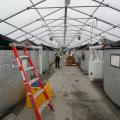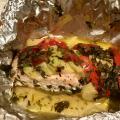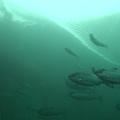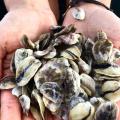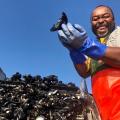This article is part of a series in our Special Report on Aquaculture in Maine. Continue reading the rest of this series at the end of this article.

Stormy, chilly, turbulent, the 36,000 square miles of gray-green ocean known as the Gulf of Maine nourish an astonishing variety of life. Sucking in the Labrador current and swirling in a counter-clockwise gyre from the eastern coast of Nova Scotia down around to the inner shore of Cape Cod, it bathes islands and peninsulas, deep bays and shallow ledges with nutrient-rich waters. Abundance brought the early Wabanaki and later Europeans to settle along this coast, establishing fishing villages and seaports, many of which exist to this day. But today that abundance is diminished.
As demand for seafood grows and wild stocks continue to decline, sustainably practiced aquaculture is starting to look like the future, both along the Maine coast and inland where fish are being raised in indoor pens.
Atlantic salmon declined decades ago, and other favored species from cod to halibut to northern shrimp to herring are increasingly hard to find. Urchins were fished practically to extinction to furnish the Japanese market, wild clams and mussels are in reduced supply, and elvers and scallops are tightly regulated. One after the other, fisheries are collapsing. While lobsters have been a success story, that fishery too has faced challenges—in the 2019 season, lobster landings were down more than 15 percent from 2018.
Inevitably, overfishing is targeted as a cause of the depletion, but decades of regulation and controls have done little to improve the situation. Today, ocean researchers recognize something fishermen have contended all along: overfishing is only one piece of the puzzle. Gulf species have been directly impacted by climate change, which has brought rapidly warming waters and increased acidification to the Gulf of Maine. For complex reasons, the gulf is warming faster than almost any other body of water in the world. Warmer temperatures drive away cold-loving species like northern shrimp. At the same time, rising acidity threatens shellfish and the plankton at the very bottom of the oceanic food chain. Eventually, if slowly, even lobsters, now in historic abundance, may crawl away east in search of colder water. “It may be in four years, it may take forty, but it will happen,” said Josh Conover, a lobster fisherman who also raises Marshall Cove Mussels off Islesboro.
What this means for the future of Maine fisheries is increasingly clear. Listen to Peter Miller, another lobster fisherman and a nascent scallop farmer: “I’ve been fishing for going on 45 years,” Miller told me one gray November morning as we watched a rain-soaked fog sock in over Tenants Harbor. “When I started, I could take my boat any time and go catch something and make a living. Lobstering in the summer and fall, scallops in the fall and winter, shrimp in the winter, groundfish in the spring. You could just go round and round the seasons and get by—you had something to do. And all of that, whether through over-fishing or government regulation or whatever, has been pretty much taken away.” As he spoke he looked up, the mildness in his tone belying the hint of bitterness I detected in his words: “It’s kind of a really messed-up system,” he said.
Miller still fishes his string of traps, still keeps an eye on his family’s wharf in this small port, but he has joined forces with a cohort of like-minded folks to form the Maine Aquaculture Coop, with the aim of farming sea scallops on Penobscot Bay sites from Stonington to Spruce Head. It has been an uphill struggle: Raising scallops, unlike oysters, mussels or salmon, is not something with a model ready to hand; the scallop farmers had to go to Japan for information. Miller is not sure he can make scallop farming his own future. But, he added, “I want to develop something younger guys can do, something fishing communities can do, to keep the money here. If I got a scallop farm up and running, I could harvest year-round, as long as they pass the toxicity test. Then,” he smiled, “I might just give up lobstering. They definitely seem to be moving east.”
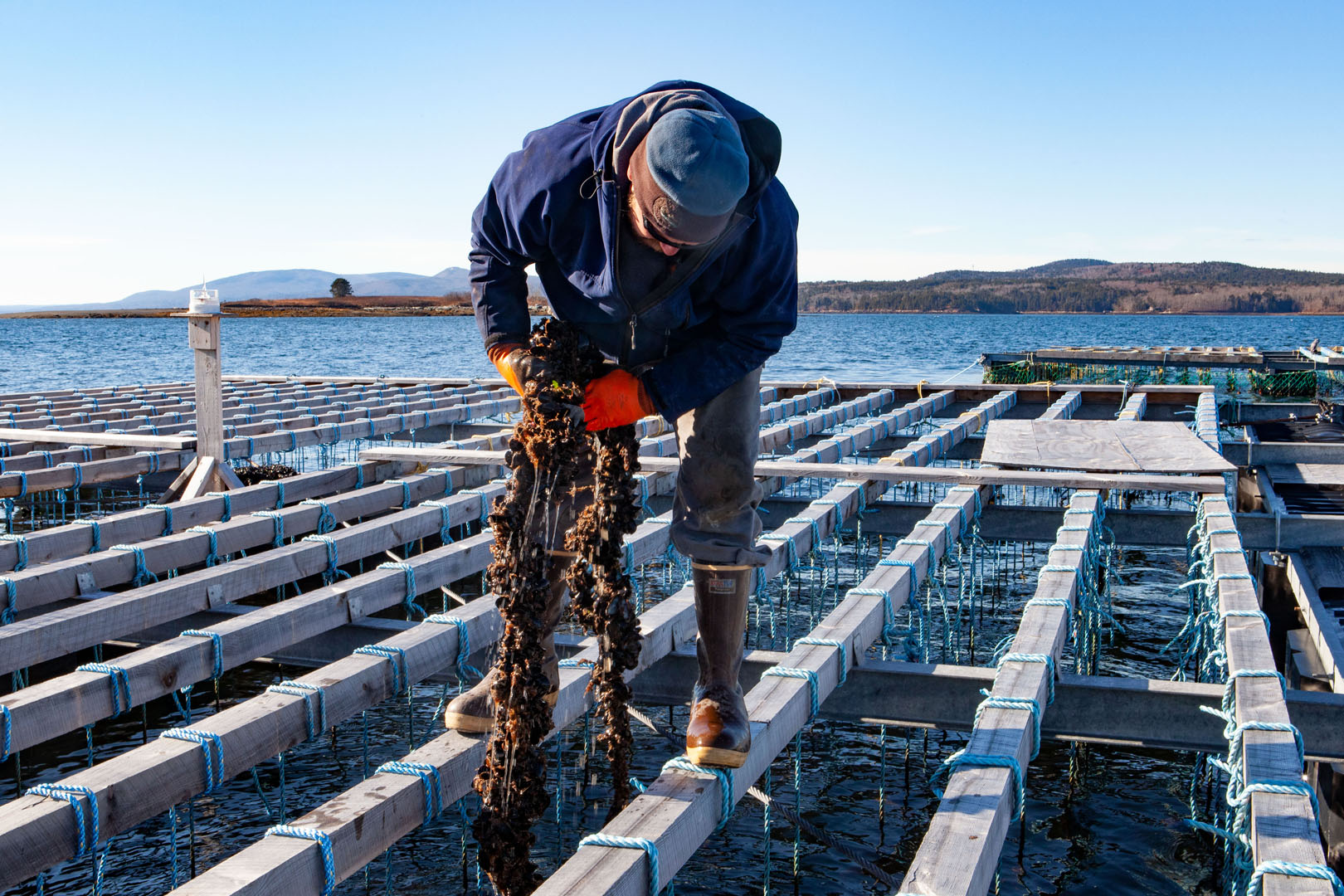
“Farmed fish? I never eat farmed fish!” I’ve heard that statement more times than I can count, and not just from misinformed consumers but also from restaurant chefs and innkeepers up and down the coast of Maine. The fact is more than 50 percent of all the seafood we consume comes from aquaculture, and that is as true in this country as in Europe or Asia. It might be scary shrimp from an environmentally destructive farm in Indonesia or salmon raised in the clean cold waters of Cobscook Bay according to Maine’s strict environmental protocols—but more than half of all seafood consumed around the world is farmed.
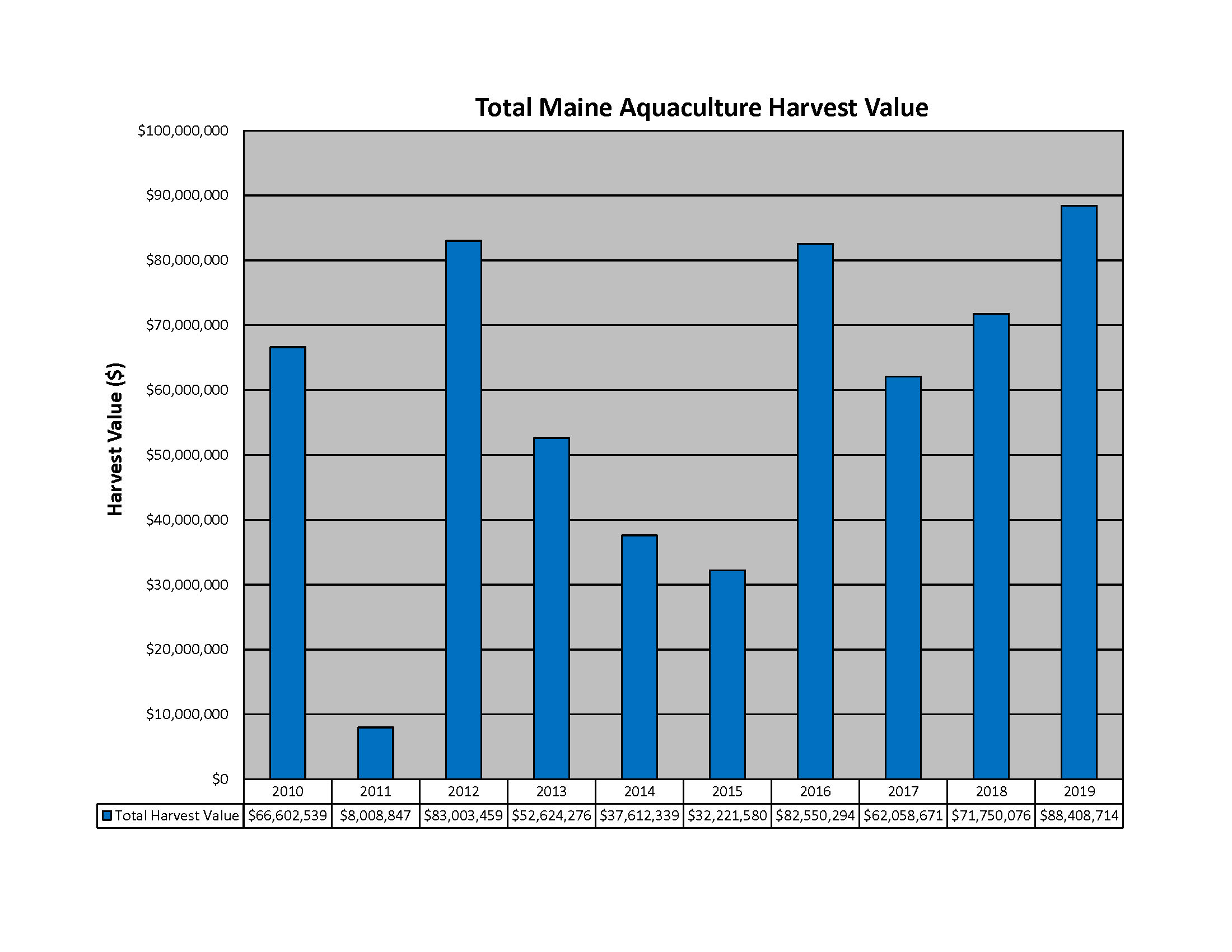
So: You never eat farmed fish? I would argue it’s possible you don’t eat any other kind.
Another statistic, possibly even more startling: More than 90 percent of the seafood consumed in the United States is imported, and a lot of it comes from U.S. harvests that are shipped to Asia for processing. Alaskan pollock goes to Asia to be turned into surimi, the fake fish served in cheap sushi restaurants. Bigger fish are sent to Asia and re-exported as frozen fillets or fish fingers. Elvers, baby eels from Maine, go to China to be grown to maturity, then to Japan to be processed into unagi, then are shipped back here to garnish a sushi platter. Next time you wrap your chopsticks around a tasty piece of unagi kabayaki and wonder where it came from—it probably started off in Maine!
With the U.S. market for seafood growing exponentially and wild fisheries under increasing pressure, aquaculture, well-regulated and sustainably practiced, offers a solution. Either supplementing lobsters or replacing them, fish farming of one sort or another is starting to look like the future for many waterfront communities in Maine—even deep inland in Caribou where the Aroostook Band of Micmacs, a tribal community, is raising fat, pink, succulent trout for high-end restaurants. Today, Maine aquaculture covers a broad spectrum of—shellfish (oysters, mussels, and scallops), finfish (salmon, trout, and newcomers in the industry, kingfish or yellowtail), eels, and even seaweed (often called sea vegetables). The markets are developing, with support from institutions and individuals alike. It’s clear that aquaculture has an important role to play in the state’s economic future.
Production in Maine is healthy, growing by 2.2 percent annually, a figure that’s been consistent over the last two decades, including throughout the 2008 economic downturn. According to Sebastian Belle, director of the Maine Aquaculture Association, there currently are 125 active sea farms in the state, plus more than 700 pending Limited Purpose Aquaculture applications. An LPA allows applicants to lease from the state 400 square feet of area for one calendar year to encourage experimentation. And lest anyone worry that ocean leases are taking over the Maine coastline, Belle said, the total put together amounts to less than a sizable Aroostook potato farm. Peter Piconi, until recently the director of the Island Institute’s Aquaculture Business Development Program, backs that up: “Look,” he said, “if you could put all the shellfish sites and all the seaweed sites together up and down the coast, they’d fit into Rockland harbor.”
The farmgate value of Maine aquaculture, according to MAA’s Belle, is between $80 and $105 million (it shifts with the salmon harvest, which varies from year to year), with an overall economic impact of $140 million. In terms of employment, that’s some 650 jobs, most of them taken by younger people. That’s important, too—the average age in aquaculture in Maine is 36; the average age of commercial fishermen is 57. In a state that is constantly seeking a younger, more productive population, that is important news.
In the past, aquaculture held negative connotations for many Mainers and it still does for a few—lobster fishermen who worry that fish farms will take over their lobster grounds, as well as shoreside dwellers who fear they might ruin the view. But it’s not exactly new here. There are two historic centers—Cobscook Bay way downeast where salmon farming got its start and still remains prime, and the Damariscotta River and its broad estuary at the entrance to Penobscot Bay. On that river, in Clarks Cove near Walpole, the University of Maine’s Darling Marine Center set up a shellfish aquaculture program back in 1970, under the direction of Dr. Herb Hidu. It was an early vision of the importance sea farming could have. Today oyster farms have spread along the coast and islands, extending from well east of Mt. Desert all the way southwest to the Piscataqua River. The business is constantly expanding but those involved say demand continues to be high for Maine’s high-quality oysters and supply will not exceed it for a long time to come.

The Darling Center also does major research in mussel, scallop, and seaweed culture, all of increasing prominence in the overall aquaculture picture. Other organizations have been equally proactive. One important outfit, also in Walpole, is the Maine Aquaculture Innovation Center, established by the state legislature in 1988; the center sponsors research projects, from developing kelp seed to improving observational buoys, in order to promote economic development in aquaculture. For hands-on training, the Island Institute launched an Aquaculture Business Development Program in 2016 to promote shellfish and seaweed farming, taking on 25 applicants each year. By early 2020, 100 participants had joined the program; and 32 of them, according to Piconi, have started up aquaculture businesses.
Aquaculture in Shared Waters is another hands-on learning platform, backed by the state university’s Maine Sea Grant program, the Maine Aquaculture Association, and Coastal Enterprises Inc., encouraging shellfish and seaweed farmers with ongoing seminars and courses. The Center for Cooperative Aquaculture Research on Taunton Bay in Franklin is yet another university-sponsored research institution that, like the Darling Center, also serves a valuable function as an aquaculture business incubator; CCAR is currently working with a Dutch company, Kingfish Zeeland, which is starting an extensive operation in Jonesport to raise kingfish (a.k.a. yellowtail or amberjack, a fish in the Seriola family) in a land-based facility. Meanwhile, the Downeast Institute on Beals, a research facility also tied to the University of Maine, undertakes major studies of shellfish, especially bivalves, and their predators, whether farmed or in the wild. It’s clear from this that the University of Maine has been in the forefront of promoting aquaculture in the state. Another indication of the university’s prominence is the large number of people active in all aspects of fish farming who have come out of university undergraduate and graduate programs.
These are just a few of the organizations that focus primarily on aquaculture. Others, such as the Gulf of Maine Research Institute in Portland or Bigelow Laboratories, an independent research group in Boothbay, include aquaculture as part of more wide-ranging interests in the oceans.
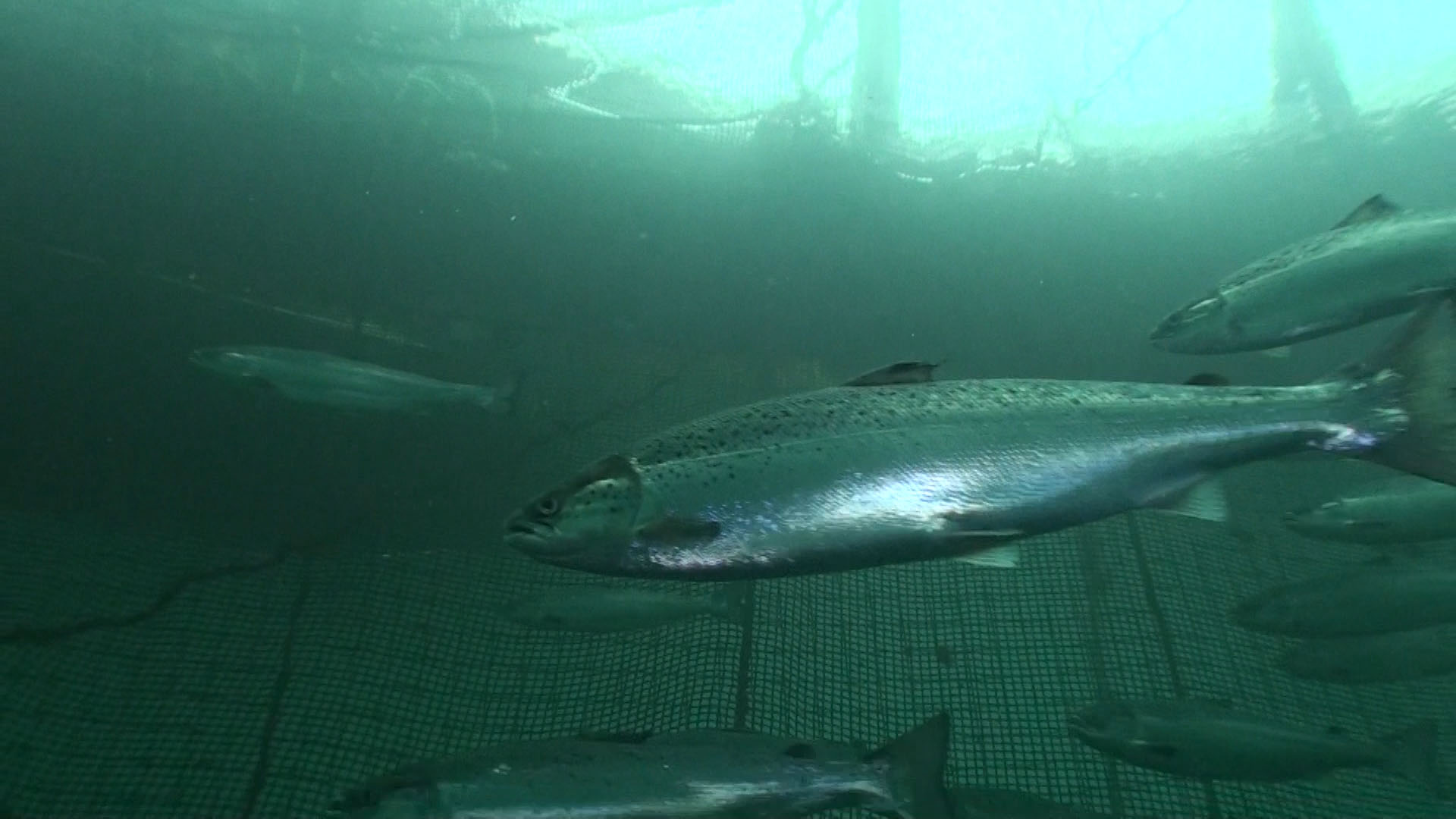
Seaweed and shellfish farms have an attraction that goes well beyond the food they provide. They also play a role in mitigating the damage climate change wreaks on the ocean environment. Ocean acidification happens when the ocean takes up excess carbon dioxide (CO2) from the atmosphere. Excess CO2 lowers the pH and calcium carbonate levels of ocean waters, and calcium carbonate is vital for the development of lobsters, oysters, and other shellfish. Susie Arnold, a marine scientist at Island Institute, explained how this works: Seaweeds, like land plants, absorb carbon dioxide and give off oxygen, just like the lettuce in your garden and the trees in your yard. They can capture enough CO2 to reduce the acidity of the surrounding water and make shellfish grow better, with stronger shells. Seaweeds also take up nitrogen and phosphorous, prevalent in some coastal waters, making a more nourishing environment for all species. Meanwhile, oysters, mussels, and scallops are filter feeders. An oyster can filter up to 50 gallons of water daily, removing both nitrogen and micro-algae that block the light that seaweeds need for photosynthesis. This is what’s called multitrophic aquaculture—the two, shellfish and seaweeds grown together. Scientists call seaweed’s ability to remediate ocean acidification “phytoremediation.” Arnold is excited about results from experiments conducted with mussel and kelp culture side by side in Casco Bay, where the positive effects could be measured and analyzed. Mussels grown close to the kelp developed thicker, denser shells. “Look,” she said in conclusion, “it’s not going to save the world. But it will have an impact at a local scale.”
FocusMaine is an initiative of Maine business people who have charged themselves with promoting a sustainable model for Maine’s economic future. In 2018 they targeted three areas where the state could excel: biopharmaceuticals, agriculture (especially organic and sustainable agriculture), and aquaculture, for which they advocated strongly. Aquaculture, the group said in its report, could add as many as 17,000 new jobs by the middle of this decade. The reasons? Increased seafood consumption both nationally and internationally; Maine’s reputation for honest products; Maine’s clean environmental record; and Maine’s population, which knows what it’s talking about when it comes to seafood.
In the end, it’s about sharing the waterfront for the benefit of all. Even those in the service trades, hotels and restaurants, understand that without a functioning working waterfront, Maine is nothing but another stop on the endless bucket list of tourism. It should be—and can be—so much more. Aquaculture, along with fishing and strong coastal communities, can help to keep it that way.
And in the end, too, there may not be a choice. Because, says Briana Warner, head of Atlantic Sea Farms, which promotes, processes, and markets Maine-grown seaweed, “Aquaculture is beautiful, and it’s hopeful.” In answer to critics who complain about threats to coastal communities, she replies with characteristic enthusiasm: “Diversifying, getting into aquaculture, that will be what helps us remain who we are. Climate change is seriously threatening our other fisheries. And if there are fewer and fewer options for people to work on the water, the whole face of our coast will change and no one wants that outcome.”
Nancy Harmon Jenkins is the author of many books and contributes to many publications, including The Wall Street Journal, the Washington Post, and Saveur.







